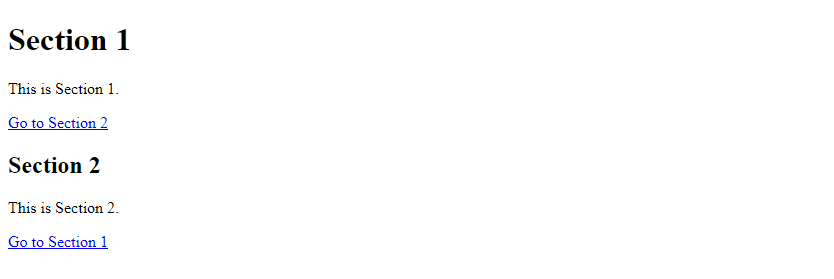在HTML中#的含义
在HTML中,# 符号通常用来表示页面内链接(anchor links)。当我们在页面中点击一个链接跳转到另一个位置时,这个链接通常会以 # 开头,后接目标元素的id属性值,用来定位页面中的特定位置。除此之外,# 也可用于URL中表示 fragment identifier(片段标识符)。
页面内链接
页面内链接通常用于在网页内部跳转到特定位置,可以帮助用户快速找到所需信息或者实现导航。在页面内链接中,# 符号后接目标元素的id属性值,浏览器会自动滚动页面到这个目标元素位置。
示例代码:
<!DOCTYPE html>
<html>
<head>
<title>页面内链接示例</title>
</head>
<body>
<h1 id="section1">Section 1</h1>
<p>This is Section 1.</p>
<a href="#section2">Go to Section 2</a>
<h2 id="section2">Section 2</h2>
<p>This is Section 2.</p>
<a href="#section1">Go to Section 1</a>
</body>
</html>
Output:

在上面的示例中,点击第一个链接”Go to Section 2″将会跳转到”Section 2″标题下,而点击第二个链接”Go to Section 1″将会跳转到”Section 1″标题下。
URL中的#符号
在URL中,# 符号后面的部分称为 fragment identifier(片段标识符)。当浏览器访问这个URL时,会自动将页面滚动到指定的锚点处。
示例代码:
<!DOCTYPE html>
<html>
<head>
<title>片段标识符示例</title>
</head>
<body>
<a href="#section1">Section 1</a>
<a href="#section2">Section 2</a>
<a href="#section3">Section 3</a>
<div id="section1">Section 1</div>
<div id="section2">Section 2</div>
<div id="section3">Section 3</div>
</body>
</html>
Output:

在上面的示例中,当用户点击不同的链接时,页面会自动滚动到相应的部分。
总结
在HTML中,# 符号用于表示页面内的链接和URL中的片段标识符。通过合理使用 # 符号,可以帮助用户更方便地浏览网页内容。
 极客教程
极客教程